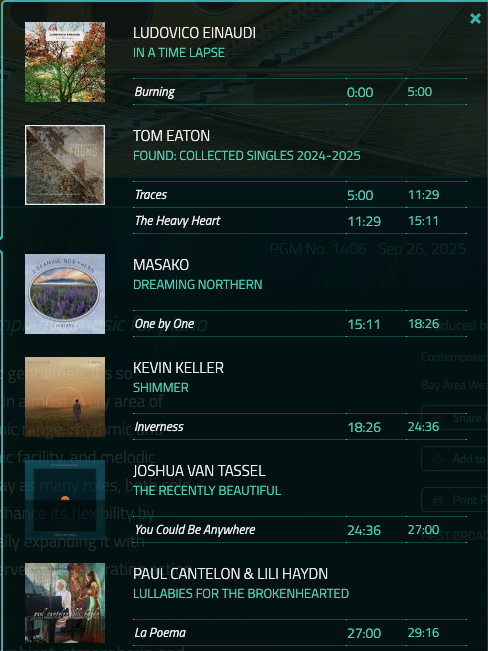
RECENT POSTS

February 13, 2024
September 2020: Shining A Light On The Path Through
Lately I’ve been considering where I’m headed with my music-making existence, and those thoughts led me back to the beginning of my creative life.
I started my “professional” career as a theatrical lighting designer. It’s a fascinating job which takes advantage of both sides of my personality; the technical, detail-oriented Tom, and the more liquid, emotional Tom.
The technical me learned to draft, learned about electricity, learned rigging, and learned how to direct a crew of stage technicians to get a lighting design from paper to actual fixtures on pipes. The artistic me learned that the degree to which you can steer an audience’s attention to a particular actor or object on the stage is, on the one hand, obvious, and on the other miraculous. And of course, you have power over the quality of the light; its color, its intensity, its density, and its direction.
A well-done lighting design draws attention to every artistic choice made in a production except the lighting itself. I learned how to be effectively invisible. It felt powerful and rewarding to be the lens through which an audience viewed the art we were creating.
Put simply, the audience follows the path created by the lighting designer. It’s quite literally the only thing they can see. The ability to invisibly guide the attention of an audience served me well when I moved somewhat laterally to sound design and eventually to opening a recording studio.
A recording engineer initially was thought of as a purely technical individual: a fellow (almost always male) who accurately captures the events that happen in the studio and delivers them faithfully to the listener. The white coats of the engineering staff at EMI/Abbey Road we’ve seen in Beatles pictures were those sorts of chaps.
But things got more complicated as options emerged over time. Technology allowed more discrete tracks to be recorded on tape, which allowed more microphones to be used, which allowed changes to be made to the balance of the recording after it was made, and allowed the addition of further musical parts after the initial recording was completed. The Beatles happened to be making music as this technology was maturing, and the progression of their work is a perfect case study in the exploration of possibilities.
This “option explosion” continues today. Now, faced with unlimited tracks and an unlimited ability to manipulate each track into what seems to be nearly anything, we’ve arrived at a place where the superstars of the engineering world don’t care at all what the original event sounded like.
Every sound that comes out of your speakers or earbuds is a fabrication, an opinion, a choice. In reality, it always has been; it’s just that today, the actual number of available subjective choices you can make about each sound within each second, each song, and each album are infinite. Of course, on the technical side, we still have to get those ones and zeros into a container (CD, MP3, etc.) that only holds a certain number of ones and zeros, but that is a very small part of the overall picture.
The recording engineer today is really quite like a lighting designer. The job is to shine a light on the best part of the work and to carry a lantern through a musical journey for the listener to follow. The quality of that “light” is infinitely variable and completely subjective. There is formulaic music, and certainly, there are successful engineers who do the same thing over and over again, but the real appeal to me of audio engineering is lighting the path through each piece of music based on the piece itself, not on the needs of the marketplace or what has come before.
To say it differently, my job has always been to frame the art of other people. To draw your attention to the things I want you to see or hear without you being aware that I am even working.
In 2016 I started releasing my own music to the public. The winter of 2015/2016 was an odd time in my life during which some key things fell apart and some other things came together. The tools to make the kinds of music I had been dreaming of making landed in my lap at the exact moment I hit an enormous emotional upheaval. In a month, I wrote and recorded an album that would become “Abendromen.” I had no intention of putting it out as its purpose was a kind of personal therapy, but I was convinced otherwise by some people I trusted.
The idea of putting out an album immediately created a problem of perspective. Choosing to release the album meant asking people to look at me, not through my eyes or ears at another person’s art, but at me directly.
I was completely unprepared to be put in a frame, even of my own making. I was unprepared to be visible. I turned down interviews, mailed only a few copies off to people at radio I knew from my work as an engineer and producer, and swept the real me into the corner while trying to celebrate the art creation of people with whom I was working. Having a light on me was terribly uncomfortable after spending so many years deliberately trying to be unseen and unheard.
But change is the constant, and I’m adapting. I’m making more and more of my own music, and I am both settling into the light of attention and embracing the role of light-bearer with my music.
I think I’ve always been trying to shine a path through; now I’m just doing it with my own notes and emotions.







